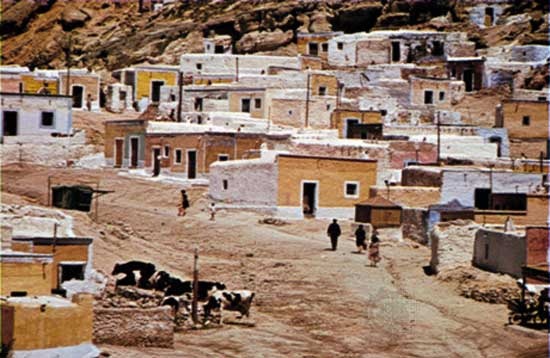Almería
Spain
 port city and capital of Almería provincia (province), in the comunidad autónoma (autonomous community) of Andalusia, southern Spain, on the Mediterranean Gulf of Almería. Known to the Romans as Portus Magnus and to the Moors as Al-Marīyah (“Mirror of the Sea”), it was captured by the Catholic Monarchs, Ferdinand II and Isabella I, in 1489. Historic landmarks include the Gothic cathedral (1524–43), built in the form of a fortress; the bishop's palace and seminary in the Moorish Alcazaba (fortress), built in 773 by the Amīr of Córdoba, ʿAbd al-Raḥmān I, on the site of a Phoenician settlement; and the ruined Castillo de San Cristóbal, which overlooks the city and harbour.
port city and capital of Almería provincia (province), in the comunidad autónoma (autonomous community) of Andalusia, southern Spain, on the Mediterranean Gulf of Almería. Known to the Romans as Portus Magnus and to the Moors as Al-Marīyah (“Mirror of the Sea”), it was captured by the Catholic Monarchs, Ferdinand II and Isabella I, in 1489. Historic landmarks include the Gothic cathedral (1524–43), built in the form of a fortress; the bishop's palace and seminary in the Moorish Alcazaba (fortress), built in 773 by the Amīr of Córdoba, ʿAbd al-Raḥmān I, on the site of a Phoenician settlement; and the ruined Castillo de San Cristóbal, which overlooks the city and harbour.Almería's architecture and dazzling brightness give it a Moroccan rather than a European appearance. The mild and sunny climate, which permits year-round swimming, backs Almería's claim to being the resort centre of the Costa de Almería (eastern part of the Spanish Mediterranean coast). After 1960 the locale became popular with filmmakers, stimulating the building of hotels and the growth of airport facilities.
Industrial activities include metalworking, canning and salting of fish, refining of oil and sulfur, and manufacture of chemicals. There is a major cement complex (including quarry, plant, and port) at Carboneras Beach (on the east coast near Murcia province). The port, which is sheltered and equipped with modern facilities, is especially busy from August to December because of the export of oranges and grapes. Almería has ferry service to the Spanish exclave of Melilla on the Moroccan coast. Pop. (2007 est.) mun., 186,651.
province, Spain
 provincia (province) in the comunidad autónoma (autonomous community) of Andalusia, southeastern Spain, bordering the Mediterranean Sea. It was formed in 1833. Primarily mountainous, Almería is crossed by sierras in which terminate successive zones of the Baetic Cordillera. The intervening valleys of the Adra, Almanzora, and Andarax rivers provide the only fertile land. Despite an average annual rainfall of about 8 inches (200 mm), several important irrigation systems have considerably increased cultivation, which has also been boosted by the use of greenhouses. Fruit and vegetable growing is the principal agricultural activity, and large quantities of tomatoes, peppers, cabbage, green beans, oranges, and white grapes are exported. Sugarcane, almonds, and esparto are also produced. Livestock is raised, especially goats and sheep.
provincia (province) in the comunidad autónoma (autonomous community) of Andalusia, southeastern Spain, bordering the Mediterranean Sea. It was formed in 1833. Primarily mountainous, Almería is crossed by sierras in which terminate successive zones of the Baetic Cordillera. The intervening valleys of the Adra, Almanzora, and Andarax rivers provide the only fertile land. Despite an average annual rainfall of about 8 inches (200 mm), several important irrigation systems have considerably increased cultivation, which has also been boosted by the use of greenhouses. Fruit and vegetable growing is the principal agricultural activity, and large quantities of tomatoes, peppers, cabbage, green beans, oranges, and white grapes are exported. Sugarcane, almonds, and esparto are also produced. Livestock is raised, especially goats and sheep.Mineral resources include iron, lead, and gold, and fine marble is quarried in the Sierra Nevada of the Baetic Cordillera. There is a flourishing ceramics industry at Níjar. Tourism is important because of the year-round resort areas along the Mediterranean coast. The village of Tabernas is the site of two solar power plants that are among the world's most advanced. An astronomical observatory, jointly operated by Spain and Germany, is located at Calar Alto, where it takes advantage of the infrequency of cloud cover over the province (unusual in Europe).
Communications focus on Almería city, the provincial capital and a seaport. Other chief towns are Adra, Berja, Cuevas del Almanzora, El Ejido, Huércal-Overa, Garrucha, and Roquetas de Mar. Area 3,388 square miles (8,775 square km). Pop. (2007 est.) 646,633.
- Malacca, sultanate of
- malachite
- malachite green
- Malachi, The Book of
- Malachy, Saint
- malacostracan
- Malagasy languages
- Malaita
- Malakbel
- Malakoff
- Malakula
- Malakāl
- Malalas, John
- Malamud, Bernard
- Malan, Daniel F
- Malan, François Stephanus
- Malang
- malanggan style
- Malanje
- Malankarese Catholic Church
- Malaparte, Curzio
- malapropism
- malaria
- Malaspina Family
- Malaspina Glacier